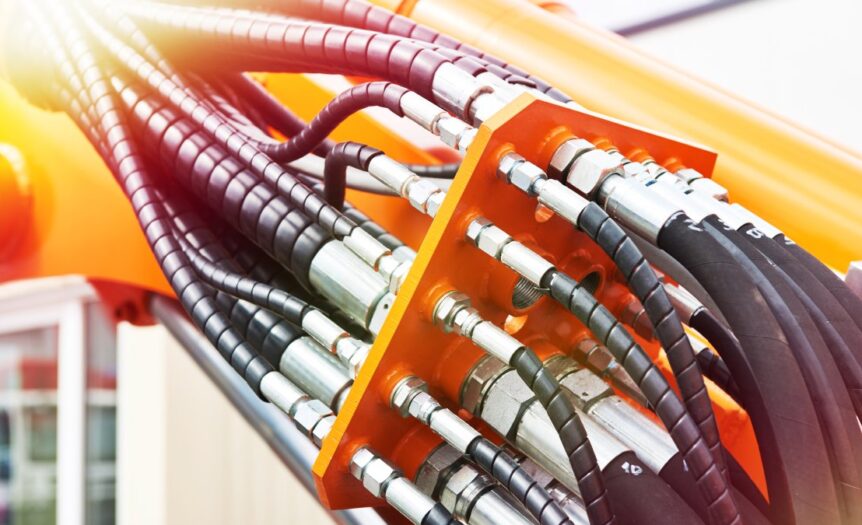Hydraulic hoses are critical in industrial operations, handling high-pressure flows to keep machinery running smoothly. However, improper installation or neglect in maintenance can result in serious hazards, from equipment damage to workplace accidents. Understanding and applying safety practices is not optional for anyone working with hydraulic systems; it’s essential. Here are practical tips to help you properly install hydraulic hoses and maintain safety on the job.
Select the Right Hydraulic Hose
Choosing the correct hydraulic hose for your specific application is the foundation of safety, so use the STAMPED method to guide your selection. This method evaluates:
- Size
- Temperature
- application
- Material
- Pressure
- Ends
- Delivery
Each of these factors ensures the hose can handle the unique demands of your system. For instance, always confirm the hose’s pressure rating matches or surpasses the system’s requirements. Verify compatibility with the fluid and operating environment to avoid unnecessary deterioration.
Handle and Store Hydraulic Hoses Correctly
Improper handling and storage can damage hydraulic hoses before they even see use. Always transport hoses carefully to avoid kinks, cuts, or abrasions. Keep hoses in a clean, dry space, away from direct sunlight or sharp objects. UV exposure, extreme temperatures, and physical damage can compromise hose integrity, increasing the risk of failure during operation.
Follow Safety Protocols During Installation
Safety starts with using proper equipment and techniques during installation. Wear appropriate personal protective equipment, including gloves and safety glasses. Make sure you secure hoses with clamps or brackets to prevent excessive movement once the system runs. Avoid overtightening fittings, as this can cause cracks or leaks. Lay hoses out without tight bends or curves to reduce stress points and improve their lifespan.
Avoid Common Installation Mistakes
Certain mistakes can jeopardize the safety and effectiveness of hydraulic hoses. Never mix old and new hoses, as inconsistent wear levels can create weak points in the system. Similarly, do not use a hose that is too short to fit comfortably in its application. Insufficient length can increase tension and lead to premature failure. Regularly check for potential hazards, such as improper routing or contact with abrasive surfaces.
Maintain Hoses Regularly for Optimal Safety
Proper maintenance is just as important as correct installation. Regularly inspect hoses for signs of wear, such as cracks, bulges, or leaks. Pay close attention to fittings and connectors, which can become loose due to vibration. Replace hoses at the first sign of damage to avoid more significant issues down the line. Frequent inspections and early replacements can dramatically reduce risks in an industrial environment.
Hydraulic hose safety depends on making the right choices, from proper selection to careful installation and regular maintenance. By implementing these best practices, you can protect personnel, extend equipment life, and prevent costly downtime. Take action today to prioritize hose safety in your operation—your team and machinery will thank you for it.










 Deering Estate
Deering Estate
 Massage Envy South Miami
Massage Envy South Miami
 Calla Blow Dry
Calla Blow Dry
 My Derma Clinic
My Derma Clinic
 Sushi Maki
Sushi Maki
 Sports Grill
Sports Grill
 The Healthy Kitchen
The Healthy Kitchen
 Golden Rule Seafood
Golden Rule Seafood
 Malanga Cuban Café
Malanga Cuban Café

 Kathleen Ballard
Kathleen Ballard
 Panter, Panter & Sampedro
Panter, Panter & Sampedro
 Vintage Liquors
Vintage Liquors
 The Dog from Ipanema
The Dog from Ipanema
 Rubinstein Family Chiropractic
Rubinstein Family Chiropractic
 Your Pet’s Best
Your Pet’s Best
 Indigo Republic
Indigo Republic




 ATR Luxury Homes
ATR Luxury Homes


 2112 Design Studio
2112 Design Studio
 Hamilton Fox & Company
Hamilton Fox & Company
 Creative Design Services
Creative Design Services
 Best Pest Professionals
Best Pest Professionals
 HD Tree Services
HD Tree Services
 Trinity Air Conditioning Company
Trinity Air Conditioning Company
 Cisca Construction & Development
Cisca Construction & Development
 Mosquito Joe
Mosquito Joe
 Cutler Bay Solar Solutions
Cutler Bay Solar Solutions


 Miami Royal Ballet & Dance
Miami Royal Ballet & Dance
 Christopher Columbus
Christopher Columbus
 Pineview Preschools
Pineview Preschools
 Westminster
Westminster
 Carrollton
Carrollton
 Lil’ Jungle
Lil’ Jungle
 Frost Science Museum
Frost Science Museum
 Palmer Trinity School
Palmer Trinity School
 South Florida Music
South Florida Music
 Pinecrest Orthodontics
Pinecrest Orthodontics
 Dr. Bob Pediatric Dentist
Dr. Bob Pediatric Dentist
 d.pediatrics
d.pediatrics
 South Miami Women’s Health
South Miami Women’s Health

 The Spot Barbershop
The Spot Barbershop
 My Derma Clinic
My Derma Clinic




 Miami Dance Project
Miami Dance Project

 Rubinstein Family Chiropractic
Rubinstein Family Chiropractic
 Indigo Republic
Indigo Republic

 Safes Universe
Safes Universe
 Vintage Liquors
Vintage Liquors
 Evenings Delight
Evenings Delight





 Atchana’s Homegrown Thai
Atchana’s Homegrown Thai
 Baptist Health South Florida
Baptist Health South Florida

 Laser Eye Center of Miami
Laser Eye Center of Miami
 Visiting Angels
Visiting Angels
 OpusCare of South Florida
OpusCare of South Florida

 Your Pet’s Best
Your Pet’s Best





 HD Tree Services
HD Tree Services
 Hamilton Fox & Company
Hamilton Fox & Company


 Creative Design Services
Creative Design Services